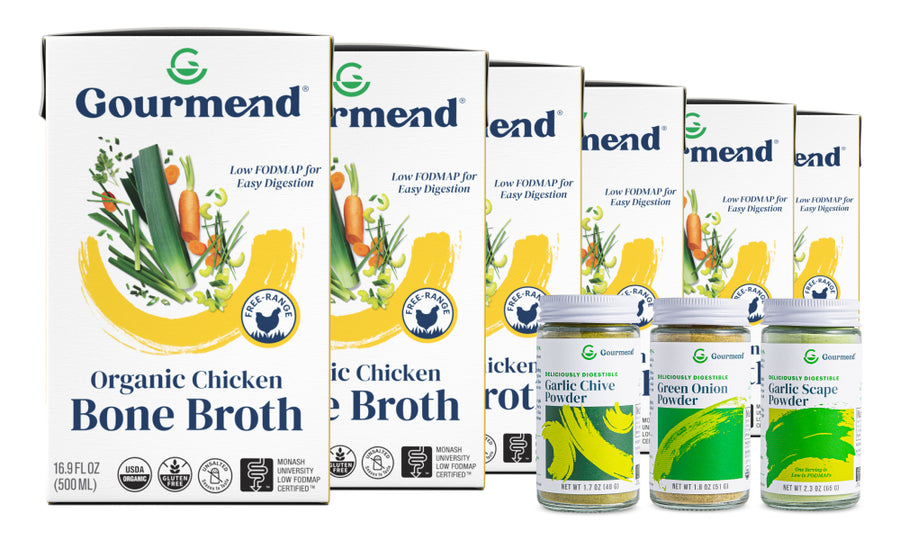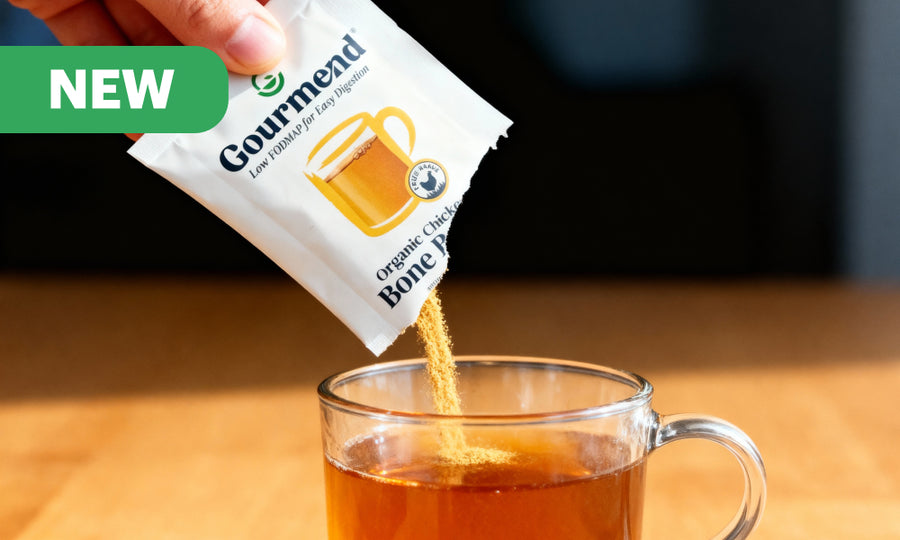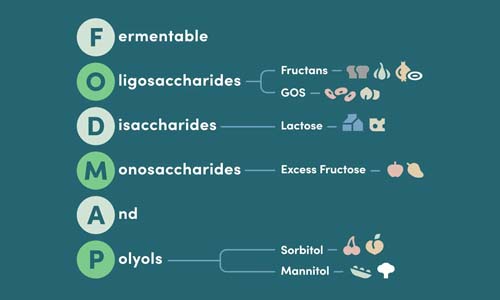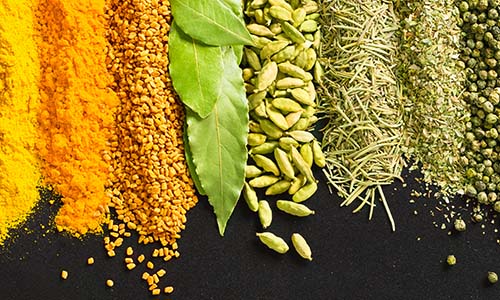Are Grapes Low FODMAP? The Complete 2025 Guide

Understanding FODMAPs and Their Importance
If you're managing IBS or digestive sensitivities, you've likely heard about the low FODMAP diet. With two-thirds of Americans experiencing digestive issues and nearly 1 billion people worldwide living with IBS, understanding which foods support comfortable digestion has never been more important. For a comprehensive overview of the low FODMAP diet and its benefits, you can refer to this Cleveland Clinic guide.
Key Takeaways
- Grapes are considered low FODMAP only in very small servings, specifically 2 grapes or about 10 grams.
- Consuming three or more grapes introduces excess fructose, making them high FODMAP.
- Monash University's latest data from June 2024 confirms these serving size guidelines for grapes.
- Understanding FODMAPs is crucial for managing IBS and digestive sensitivities.
- A significant portion of the global population experiences digestive issues, highlighting the importance of dietary awareness.
Table of Contents
What Are FODMAPs?
FODMAPs are Fermentable Oligosaccharides, Disaccharides, Monosaccharides, and Polyols—a group of short-chain carbohydrates that can be difficult for some people to digest. Think of them as naturally occurring sugars and fibers that, while healthy for many people, can cause significant discomfort for those with sensitive digestive systems.
In individuals with irritable bowel syndrome (IBS) or sensitive digestion, FODMAPs can trigger a cascade of uncomfortable symptoms. When these carbohydrates reach the colon undigested, they ferment, producing gas and drawing water into the intestines. This process can lead to:
- Bloating and abdominal distension
- Gas and flatulence
- Abdominal pain and cramping
- Diarrhea or constipation
- General digestive discomfort
The Importance of FODMAP Management
Research consistently shows that reducing FODMAP intake can significantly alleviate digestive symptoms for many people with IBS. The low FODMAP diet isn't about permanent restriction—it's a systematic approach to identifying your personal trigger foods while maintaining nutritional balance.
The low FODMAP approach works in phases: elimination, reintroduction, and personalization. The goal is to expand your diet as much as possible while keeping symptoms at bay.
This is where understanding specific foods like grapes becomes crucial. When you're navigating ingredient lists and meal planning, knowing exactly how much of each food you can comfortably enjoy makes the difference between feeling restricted and feeling empowered.
Grapes and Their FODMAP Content: The Complete Picture
Here's where things get interesting—and slightly complicated. The FODMAP classification of grapes has undergone significant changes in recent years, making it one of the more confusing fruits for people following a low FODMAP diet. For a detailed research update on grapes and the low FODMAP diet, see this in-depth article from A Little Bit Yummy.
Why Grapes Have Been Retested
You might wonder why a fruit's FODMAP status would change. The answer lies in the natural complexity of food science and the ongoing commitment to accuracy in FODMAP research.
- Natural Variability
- Grape varieties, farming practices, climate conditions, ripening stages, and storage methods all influence FODMAP content. A grape grown in California might have different fructose levels than one grown in Australia.
- Improved Testing Methods
- As laboratory techniques become more sophisticated, researchers can detect and measure FODMAPs with greater precision, leading to more accurate serving size recommendations.
- Ongoing Research Commitment
- Monash University and FODMAP Friendly labs periodically re-analyze foods to ensure their databases reflect the most current and accurate information available.
Historical Changes in Grape FODMAP Classification
The evolution of grape classification tells a fascinating story about how food science continues to refine our understanding:
- Pre-2021: Grapes were considered FODMAP-free or low FODMAP, with generous serving sizes up to 1 cup
- December 2021: Monash University reduced the low FODMAP serving to around 6 grapes
- June 2024: The most recent update limited low FODMAP servings to just 2 grapes
This dramatic reduction reflects more precise testing that revealed higher fructose levels than previously detected. For many people following the low FODMAP diet, this change came as a surprise—and understandably so.
Current FODMAP Serving Sizes for Different Types of Grapes
Here's where the grape story becomes even more nuanced. Different testing laboratories have produced varying results, creating some confusion in the FODMAP community. Let's break down what we know from the two primary FODMAP testing authorities.
Monash University Findings (June 2024)
Monash University, the original developers of the low FODMAP diet, provides the most conservative recommendations:
According to Monash data, servings of 15 grapes (approximately 75g) or more are definitively high FODMAP. This means that what many people would consider a small handful of grapes actually exceeds the recommended serving size by a significant margin.
FODMAP Friendly Lab Findings
The FODMAP Friendly certification program, another respected testing authority, has produced notably different results:
| Grape Type | Low FODMAP Serving | Primary FODMAP |
|---|---|---|
| White grapes | 24-26g (~24 grapes) | Fructose and fructans |
| Red grapes | 150g (about 1 cup) | Fructans (not fructose) |
| Black grapes | 100g | Multiple FODMAPs at low levels |
- White grapes: Low FODMAP at 24-26g (approximately 24 grapes) with fructose and fructans present
- Red grapes: Low FODMAP at 150g (about 1 cup); main FODMAP is fructans, not fructose
- Black grapes: Low FODMAP at 100g; contain very low levels of multiple FODMAPs
These conflicting findings create a real challenge for people following a low FODMAP diet. The safest approach is to follow the more conservative Monash guidelines during your elimination phase, then test your personal tolerance during reintroduction.
| Grape Type | Monash University | FODMAP Friendly | Main FODMAP |
|---|---|---|---|
| Green/White Seedless | 2 grapes (10g) | 24-26g (24 grapes) | Excess fructose |
| Red Grapes | 2 grapes (10g) | 150g (1 cup) | Fructans/fructose |
| Black Grapes | 2 grapes (10g) | 100g | Multiple FODMAPs (low levels) |
Understanding Fructose in Grapes
The primary FODMAP concern with grapes is excess fructose. This occurs when a fruit contains more fructose than glucose, making it harder for some people to absorb properly. When fructose isn't absorbed in the small intestine, it travels to the colon where it ferments, causing the familiar symptoms of gas, bloating, and digestive discomfort.
Practical Implications for Your Low FODMAP Journey

Now that we understand the science behind grapes and FODMAPs, let's talk about what this means for your daily life and meal planning.
Should You Remove Grapes from Your Diet?
The answer depends on where you are in your low FODMAP journey and how your body responds to small amounts of grapes:
- During Elimination Phase
- If you're new to the low FODMAP diet or experiencing ongoing symptoms, it's prudent to eliminate grapes completely for 2-6 weeks. This gives your digestive system time to settle and provides a clear baseline for reintroduction.
- During Reintroduction Phase
- Start with the conservative Monash recommendation of 2 grapes and monitor your symptoms for 24-48 hours. If you tolerate this amount well, you might gradually test slightly larger portions.
- In Personalization Phase
- Some people find they can handle more than 2 grapes without symptoms, while others may need to avoid them entirely. Your personal tolerance is what matters most.
Grapes in Recipes and Meal Planning
The reality of a 2-grape serving size means you'll need to get creative with how you incorporate grapes into your cooking and snacking:
- Use grapes as a garnish rather than a main ingredient
- Slice 2 grapes and distribute throughout a salad for bursts of sweetness
- Save grapes for special occasions rather than daily snacking
- Focus on other low FODMAP fruits for regular consumption
When adjusting recipes that call for grapes, consider these low FODMAP fruit substitutions that offer similar sweetness and texture:
- Strawberries: Low FODMAP up to 1 cup, offering natural sweetness and vibrant color
- Cantaloupe: Low FODMAP up to 1 cup, provides juicy texture similar to grapes
- Orange segments: Low FODMAP up to 1 medium orange, adds citrus brightness
- Blueberries: Low FODMAP up to 1/4 cup, offers similar bite-sized convenience
Understanding Cumulative FODMAP Intake
Here's something crucial that many people overlook: FODMAP stacking. Even if individual foods are within their low FODMAP serving sizes, consuming multiple low FODMAP foods together can create a cumulative effect that triggers symptoms.
If you're having 2 grapes with your lunch, be mindful of other fruits and FODMAP-containing foods in the same meal. The total FODMAP load matters as much as individual serving sizes.
This is particularly important to remember when preparing fruit salads, smoothies, or snack plates. What seems like a collection of "safe" foods might actually exceed your tolerance threshold when combined.
Special Considerations for Children with IBS
Managing a low FODMAP diet for children requires extra care and professional guidance. Here's what parents need to know about grapes and kids:
For children following a low FODMAP diet:
- The 2-grape limit still applies, but portion sizes might be adjusted based on body weight
- Focus on the nutritional benefits grapes do provide: hydration, antioxidants, and natural energy
- Make the small serving feel special rather than restrictive
- Ensure adequate fruit intake from other low FODMAP options
Other Grape Products to Consider
When we talk about grapes and FODMAPs, it's important to consider processed grape products as well:
- Grape Juice
- Generally not low FODMAP due to concentrated fructose levels. The juicing process removes fiber while concentrating sugars, making it more likely to trigger symptoms.
- Raisins
- Low FODMAP at very small servings (about 1 tablespoon or 13g), but the concentrated nature of dried fruit means it's easy to exceed safe portions.
- Wine
- The fermentation process changes the FODMAP profile significantly. Most wines are considered low FODMAP in moderate amounts, though individual tolerance varies.
- Grape Juice
- Generally not low FODMAP due to concentrated fructose levels. The juicing process removes fiber while concentrating sugars, making it much more likely to trigger symptoms.
- Raisins and Dried Grapes
- Low FODMAP at very small servings (about 1 tablespoon or 13g), but the concentrated nature of dried fruit means FODMAPs are much more concentrated too.
- Wine
- The fermentation process typically reduces FODMAP content, and most wines are considered low FODMAP in moderate amounts. However, sweet wines may retain more residual sugars.
Staying Current with FODMAP Research
One of the most important lessons from the grape classification changes is the need to stay updated with current research. FODMAP science continues to evolve as testing methods improve and more foods are analyzed.
Here's how to stay informed about FODMAP updates:
- Download the official Monash University Low FODMAP Diet App
- Follow FODMAP Friendly certification updates
- Work with a registered dietitian who specializes in digestive health
- Join reputable online communities focused on evidence-based FODMAP information
At Gourmend Foods, we understand how frustrating these changing guidelines can be. That's why we've created our low FODMAP recipe conversion tool to help you adapt your favorite recipes as new information becomes available.
Better Alternatives for Grape Cravings
If you're missing the convenience and sweetness of grapes, here are some low FODMAP alternatives that can satisfy similar cravings:
Fresh Fruit Alternatives
- Strawberries: Up to 1 cup - naturally sweet with similar juiciness
- Cantaloupe: Up to 1 cup - refreshing and hydrating like grapes
- Kiwi fruit: Up to 2 medium fruits - tangy-sweet flavor profile
- Pineapple: Up to 1 cup fresh - tropical sweetness and natural enzymes
Recipe Adaptations
When modifying recipes that traditionally use grapes, consider the role grapes played in the original dish:
For salads where grapes provided sweetness and texture, try diced strawberries or mandarin orange segments. For cooking applications where grapes added moisture and subtle sweetness, consider using our low FODMAP vegetable broth to build complex flavors without digestive discomfort.
Our low FODMAP recipe collection includes creative ways to build satisfying meals that don't rely on high FODMAP fruits for flavor.
Managing Social Situations
One challenge many people face is navigating social situations where grapes are commonly served - parties, picnics, and casual gatherings. Here's how to handle these scenarios:
- Eat before attending events to avoid feeling deprived
- Bring your own low FODMAP snacks to share
- Focus on other foods and social connections rather than restrictions
- Have a plan for explaining your dietary needs simply and confidently
Long-term Success with FODMAPs
The grape situation perfectly illustrates why the low FODMAP diet is meant to be a three-phase process, not a permanent restriction. Understanding this framework helps put the grape guidelines into perspective.
The Three-Phase Approach with Grapes
- Phase 1: Elimination (2-6 weeks)
- Follow the strict 2-grape limit or eliminate grapes entirely to establish symptom baseline. This phase helps your digestive system settle and provides clear data for the next phase.
- Phase 2: Reintroduction (6-10 weeks)
- Systematically test different amounts of grapes on separate occasions. Start with 2 grapes, then potentially try 4-5 grapes a few days later if the smaller amount was well-tolerated.
- Phase 3: Personalization (ongoing)
- Based on your reintroduction results, establish your personal grape tolerance. Some people may handle 6-8 grapes occasionally, while others may need to stick to 2 grapes or avoid them entirely.
Building Confidence in Food Choices
The changing grape guidelines can feel overwhelming, but they actually demonstrate something positive: FODMAP research is active and improving. This means better, more accurate information for managing digestive health.
At Gourmend Foods, we've seen our customers navigate these challenges successfully by focusing on abundance rather than restriction. Our organic, low FODMAP broths and seasonings help create flavorful, satisfying meals that don't depend on potentially triggering ingredients.
Final Recommendations
Based on current research and practical experience with low FODMAP eating, here are our key recommendations for grapes:
- Start conservatively: Follow the Monash recommendation of 2 grapes during elimination phase
- Test systematically: During reintroduction, test grapes on their own, not mixed with other potential triggers
- Consider timing: Some people tolerate small amounts of higher FODMAP foods better at certain times of day or when their digestive system is less stressed
- Focus on variety: Don't let grape restrictions limit your overall fruit intake - there are many delicious low FODMAP options
- Stay flexible: Your tolerance may change over time as your digestive health improves
Whether you can enjoy 2 grapes or need to avoid them entirely, you can still create delicious, satisfying meals that support your digestive health. The key is having the right tools, ingredients, and information to make confident food choices.
With nearly 1 billion people worldwide living with IBS and two-thirds of Americans experiencing digestive issues, you're not alone in navigating these dietary considerations. The growing body of FODMAP research, including the evolving guidelines around grapes, represents progress toward better understanding and management of digestive health.
Check out our Low Fodmap Bundles
Frequently Asked Questions
How many grapes can I eat on low FODMAP?
On a low FODMAP diet, you can generally enjoy about 15 grapes per serving without triggering digestive symptoms. This portion size keeps you within the recommended limit for fructose, the sugar in grapes that can cause discomfort in larger amounts.
Are grapes good for IBS sufferers?
Grapes can be a good fruit choice for people with IBS because they are low FODMAP in moderate servings and contain antioxidants and hydration benefits. They offer a sweet, juicy option that’s gentle on digestion when eaten in controlled amounts.
What is the lowest FODMAP fruit?
Some of the lowest FODMAP fruits include strawberries, blueberries, oranges, and kiwi. These fruits have minimal fermentable sugars, making them easier to digest and less likely to cause bloating or discomfort.
Why are apples not on FODMAP?
Apples are not considered low FODMAP because they contain high amounts of fructose and sorbitol, two types of fermentable sugars that can cause gas, bloating, and other IBS symptoms when eaten in typical serving sizes.
What fruit is not good for IBS?
Fruits high in fructose and polyols, like apples, pears, cherries, and watermelon, are usually not good choices for IBS sufferers. These fruits can ferment quickly in the gut, leading to discomfort such as gas, bloating, and cramps.
Is coffee low in FODMAP?
Coffee itself is low FODMAP, but it can still irritate the gut due to its acidity and caffeine content. Many people with IBS find that moderate coffee intake is okay, but it’s important to watch your body’s response and avoid additives like high FODMAP creamers or sweeteners.





